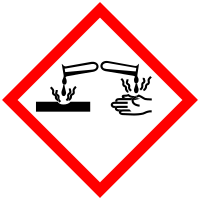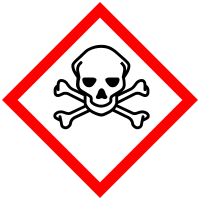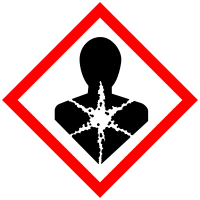
Improving Member States preparedness to face an HNS pollution of the Marine System (HNS-MS)
Formaldehyde Solutions (45% Or Less)
Description Top
| CAS number | 50-00-0 |
| UN number | 1198 |
| Chemical formula | CH2O |
| Standard European Behaviour Classification (SEBC) | Dissolves (D) |
| Abilities | Solution. |
GESAMP Hazard profile
| A1 | A2 | B1 | B2 | C1 | C2 | C3 | D1 | D2 | D3 | E1 | E2 | E3 |
| 0 | R | 2 | NI | 2 | 2 | 3 | 3 | 3 | CMSs | NT | D | 3 |
Marine pollution Classification (MARPOL Annex II)
| Category | Description |
| Y | Noxious Liquid Substances which, if discharged into the sea from tank cleaning or deballasting operations, are deemed to present a hazard to either marine resources or human health or cause harm to amenities or other legitimate uses of the sea and therefore justify a limitation on the quality and quantity of the discharge into the marine environment. |
Alternate names for this chemical
Formaldehyde Solutions (45% Or Less)
Solutions De Formaldhyde (45% Ou Moins)
Solutions De Formaldhyde (45% Ou Moins)
Physico-chemical properties Top
| Chemical formula | CH2O | |
| Molar mass | 30.026 [g/mol] | |
| State | Liquid at 25°C and 1 atm | |
| Hydrosolubility |
|
Behaviour Top
| Standard European Behaviour Classification (SEBC) | Dissolves (D) |
Ecotoxicity Top
| Lowest median lethal concentration (LC50) on algae | 14.7 [mg/l] | |
| Lowest median lethal concentration (LC50) on crustacean | 14.7 [mg/l] | |
| Lowest median lethal concentration (LC50) on fishes | 6.7 [mg/l] | |
| Predicted No Effect Concentration (PNEC) |
|
Hazards Top



Danger
Hazards statements
Health
H301
Toxic if swallowed.
H311
Toxic in contact with skin.
H314
Causes severe skin burns and eye damage.
H317
May cause an allergic skin reaction.
H331
Toxic if inhaled.
H351
Suspected of causing cancer.
Precautionary statements
Prevention
P201
Obtain special instructions before use.
P260
Do not breathe dust/fume/gas/mist/vapours/spray.
P280
Wear protective gloves/protective clothing/eye protection/face protection.
Response
P312
Call a POISON CENTER or doctor/physician if you feel unwell.
P361
Remove/Take off immediately all contaminated clothing.
P303 + P361 + P353
IF ON SKIN (or hair): Remove/Take off immediately all contaminated clothing. Rinse skin with water/shower.
P370 + P378
In case of fire: Use ... for extinction.
Storage
P403 + P233
Store in a well-ventilated place. Keep container tightly closed.
GESAMP Top
GESAMP Hazard profile
| A1 | A2 | B1 | B2 | C1 | C2 | C3 | D1 | D2 | D3 | E1 | E2 | E3 |
| 0 | R | 2 | NI | 2 | 2 | 3 | 3 | 3 | CMSs | NT | D | 3 |
A1: Bioaccumulation
| Rating | Description |
| 0 | No potential to bioaccumulate |
A1a:
| Rating | Description | Criteria [mg/l] |
| 0 | No potential to bioaccumulate | Log Kow < 1 |
A1b:
| Rating | Description |
| NI | No Information |
A2: Biodegradation
| Rating | Description |
| R | Readily biodegradable |
B1: Acute aquatic toxicity
| Rating | Description | Criteria [mg/l] |
| 2 | Slightly toxic | 10 < LC/EC/IC50 ≤ 100 |
B2: Chronic aquatic toxicity
| Rating | Description |
| NI | No Information |
C1: Acute oral toxicity
| Rating | Description | Criteria [mg/Kg] |
| 2 | Moderate | 50 < AOTE ≤ 300 |
C2: Acute dermal toxicity (skin contact)
| Rating | Description | Criteria [mg/Kg] |
| 2 | Moderate | 200 < ADTE ≤ 1000 |
C3: Acute inhalation toxicity
| Rating | Description | Criteria [mg/l] (4 hours exposure) |
| 3 | Moderately high | 0.5 < AITE ≤ 2 |
D1: Skin irritation or corrosion
| Rating | Description | Sign | GHS category |
| 3 | Severely irritating or corrosive | Severe irritation indi | Corrosive Category 1 |
D2: Eye irritation
| Rating | Description | Sign | GHS category |
| 3 | Severely irritating or corrosive | Severe conjunctoblepha | Irritant Category 1 |
D3: Long-term health effects
| Notation | Hazard endpoint | Description | GHS category |
| C | Carcinogenicity | Chemicals which have been shown to induce or increase the incidence of cancer | Category 1 for Carcinogens |
| M | Mutagenicity | Cause a permanent change in the amount or structure of genetic material in cells | Categories 1 and 2 for Germ Cell Mutagens |
| Ss | Skin Sensitization | Cause specific skin hypersensitivity or allergy following skin contact | Category 1 for Skin Sensitizers |
E1: Tainting of seafood
| Rating | Description |
| NT | The substance has been tested for tainting and found not to taint following exposure of the fish for 24h to 1mg/l. |
E2: Behaviour of chemicals in the marine environment
| Rating | Description |
| D | Dissolves |
E3: Interference with the use of coastal amenities
| Rating | Interference | Description | Interpretation | Warning |
| 3 | Highly objectionable | 1 is highly acutely toxic; and/or 2 is severely irritant or corrosive to skin or eyes; and/or 3 is carcinogenic, mutagenic or reprotoxic; and/or 4 is a floater or persistent floater with associated health effects | 1 C1 and/or C2 and/or C3 = 4; and/or 2 D1 or D2 = 3, 3A, 3B, or 3C; and/or 3 D3 contains C, M or R; and/or 4 E2 = F or Fp and D3 contains Ss, Sr, T, A, N, or I | Warning issued leading to the closure of amenities |
GHS Security Information



Danger
About the project
HNS-MS is a decision-support tool that Belgian and French maritime authorities as well as coastguard stations can activate in order to forecast the drift, fate and behavior of acute marine pollution by Harmful Noxious Substances (HNS) accidentally released in the marine system.
Contact us
Copyright © 2015–2025 HNS-MS Consortium
 HNS-MS has been funded by DG-ECHO under agreement ECHO/SUB/2014/693705 and runs from 1 January 2015 to 31 March 2017.
HNS-MS has been funded by DG-ECHO under agreement ECHO/SUB/2014/693705 and runs from 1 January 2015 to 31 March 2017.